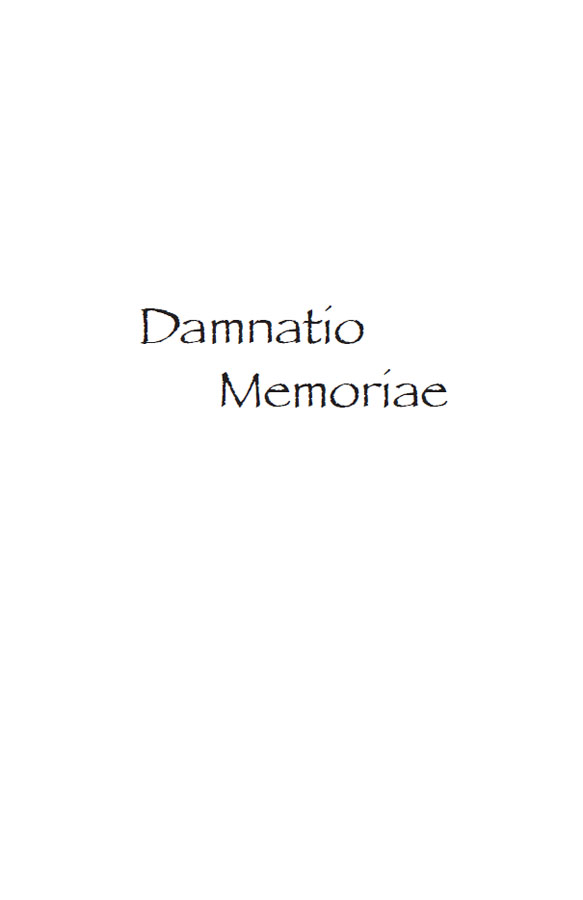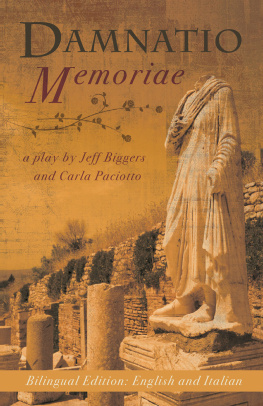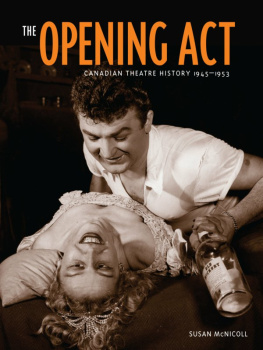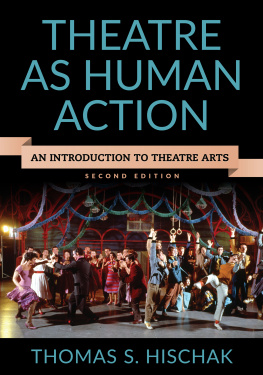Other works by Jeff Biggers
Nonfiction
State Out of the Union:
Arizona and the Final Showdown
Over the American Dream
The United States of Appalachia:
How Southern Mountaineers Brought Independence, Culture, and Enlightenment to America
Reckoning at Eagle Creek:
The Secret Legacy of Coal in the Heartland
In the Sierra Madre

Damnatio Memoriae: a play / una commedia
2015 by Wings Press, for Jeff Biggers and Carla Paciotto
Cover painting, xxxx xxxx by xxxx
First Wings Press Edition
Printed edition ISBN: 978-1-60940-461-1
Ebooks:
ePub ISBN: 978-1-60940-462-8
Kindle/mobipocket ISBN: 978-1-60940-463-5
Library PDF ISBN: 978-1-60940-464-2
Wings Press
627 E. Guenther
San Antonio, Texas 78210
Phone/fax: (210) 271-7805
On-line catalogue and ordering:www.wingspress.com
All Wings Press titles are distributed to the trade by
Independent Publishers Group
www.ipgbook.com
Library of Congress Cataloging-in-Publication Data
Biggers, Jeff, 1963
Damnatio memoriae : a play / una commedia / by Jeff Biggers and Carla Paciotto. -- First Wings Press edition.
pages cm
A Bilingual Edition in English and Italian.
ISBN 978-1-60940-461-1 (pbk. : alk. paper) -- ISBN 978-1-60940-462-8 (ebook) -- ISBN 978-1-60940-463-5 (kindle/mobipocket ebook) -- ISBN 978-1-60940-464-2 (library pdf)
I. Paciotto, Carla. II. Title.
PS3602.I366D36 2015
812.6--dc23
2015007715
Contents Indice
In memory of all those who have lost their lives crossing the Mediterranean Sea.
gens una sumus

Dedicato a tutti coloro che hanno
perso la vita attraversando il Mar Mediterraneo.
gens una sumus
Acknowledgments
The authors would like to thank Guido Ferrarini and the entire crew at Teatroaperto in Bologna, ItalyTiziano Tommesani, Piero Ferrarini, Renata Fiorentini, Shoshanna Zuckermanfor their collaboration on Damnatio Memoriae and the Mare Nostrum Theatre Project.
Our work springs from our 25-year friendship and collaboration with Guy Lydster and Licia Catapano, and our dear community of friends in Bologna. Deepest gratitude for all of your support.
Thanks to Bridget Shanahan for the cover design. And, sopratutto, grazie mille to publisher Bryce Milligan, for his support and long-time literary work beyond borders.
Ringraziamenti
Ringraziamo Guido Ferrarini e il Centro Culturale Teatroaperto-Teatro Dehon, Tiziano Tommesani, Piero Ferrarini, Renata Fiorentini e Shoshanna Zuckerman, per la collaborazione al Progetto Teatrale Mare Nostrum e Damnatio Memoriae.
Il nostro lavoro frutto dellamicizia e della collaborazione ventennale con Guy Lydster e Licia Catapano e con i nostri di amici di Bologna. Vi siamo profondamenti grati per tutto il vostro supporto.
Un ringraziamento a Bridget Shanahan per il disegno di copertina. Soprattutto grazie mille alleditore Bryce Milligan per lincoraggiamento e per il suo instancabile lavoro a sostegno della letteratura al di l delle frontiere.
Introduction
I stood under the Arch of Septimius Severus in the Roman Forum for the first time as an American expatriate in 1989. Twenty-five years later, I saw it as an international stage.
The stage of Ancient Rome. In the time of an immigration crisis. Two clashing theatre troupesone Italian, one composed of immigrants. Two interpretations of Shakespeares role of Aaron the Moor in Titus Andronicus. Two views over the lost history of todays moors, and the influence of Africans and Arabs in shaping Ancient Rome. Amid the clash of cultures, a new play emerges beneath that Arch; a journey of migration in modern Italy and the Mediterranean Sea that unites cultures from around the world on the stage.
An early version of this theatrical vision first took form in 1989, when Carla and I huddled in a small cottage in the Apennines hills, not far from Bologna. We set out to write a multilingual play about new immigrants; the African street vendors, the always nameless, stateless and disparaged vu compra.
We wondered: How could the stage provide a safe, healing and creative space, as well as a historical and narrative context, for immigrant stories to be voiced and heard.
Those were intense days in Italy. After South African refugee Jerry Essan Masslo was murdered that summer by local thugs in the tomato fields of southern Italy, thousands of Italians took to the streets in Rome to advocate for civil rights for immigrants. Italy had shifted from being a country of emigration to a country of immigration; but the nations grasp of tolerance and diversity was still in progress.
Twenty-five years later, retracing those steps in Rome, I realized todays immigrants continue to walk along the ancient road of Via Appia, where a mysterious Septizodium monument constructed by Libyan-born Emperor Septimius Severus in Ancient Rome once welcomed their arrival from Africa.
The Septizodium is gone, of course, long since dismantled into pieces and distributed into the far corners of the Eternal City like uncollected stories from Ancient Rome. The Arch of Septimius Severus has endured.
In his Nobel lecture in 1990, Mexican author Octavio Paz invoked the presence of the past in his own ancient world. The temples and gods of pre-Columbian Mexico are a pile of ruins, but the spirit that breathed life into that world has not disappeared; it speaks to us in the hermetic language of myth, legend, forms of social coexistence, popular art, customs. For Paz, being a Mexican writer meant listening to the voice of that present, that presence.
The presence of the Ancient Roman past can be powerful, even threatening. Libyan dictator Muammar Gaddafi dramatically removed an antique bronze statue of Severus in the 1990s, when the Emperors presence served as a mustering ground for the opposition in Tripolis Green Square (todays Martyr Square).
Gaddafi wasnt the first person to condemn histories, especially those in the time of Severus, whose family dynasty and the Syrian family of his Empress Julia Domnaruled the Roman Empire from 193-235, during an extraordinary period of expansion.
The Ancient Romans called it damnatio memoriae, the act of damning (and removing) someones memory or existence from all monuments, when found objectionable by the emperor. This included Geta, the son of Severus, who would eventually be brutally murdered by his jealous brothers accomplices in a power struggle.
Getas name had been chiseled out of the Arch of Septimius Severus. His face disappeared from a famed painted wooden tondo, dated 199, of the Severus family.
What if Geta returned to the stage, censored stones in hand, and demanded to be re-inserted back into our historical memory? What unknown stories would we learn about his familys tragic dynasty and their impact on Ancient Rome, shaped by a Libyan-born father and a Syrian-born mother?
The theatre is the perfect forum for such a timebend, as Arthur Miller invoked in his own memoir, where the past and present speak to each other in the language of memory.
Nearly two thousand years later, such a legacy has been overshadowed by an unprecedented crisis over immigration in Italy. By the spring of 2015, over 218,000 refugees and immigrants, mainly from Africa and Syria, embarked from Severus Libyan ports to make the dangerous voyage across the sea, the mare nostrum of Ancient Rome. With more than 3,500 deaths in 2014-2015, the International Organization for Migration hailed the passage as the deadliest migrant crossing in the world.








